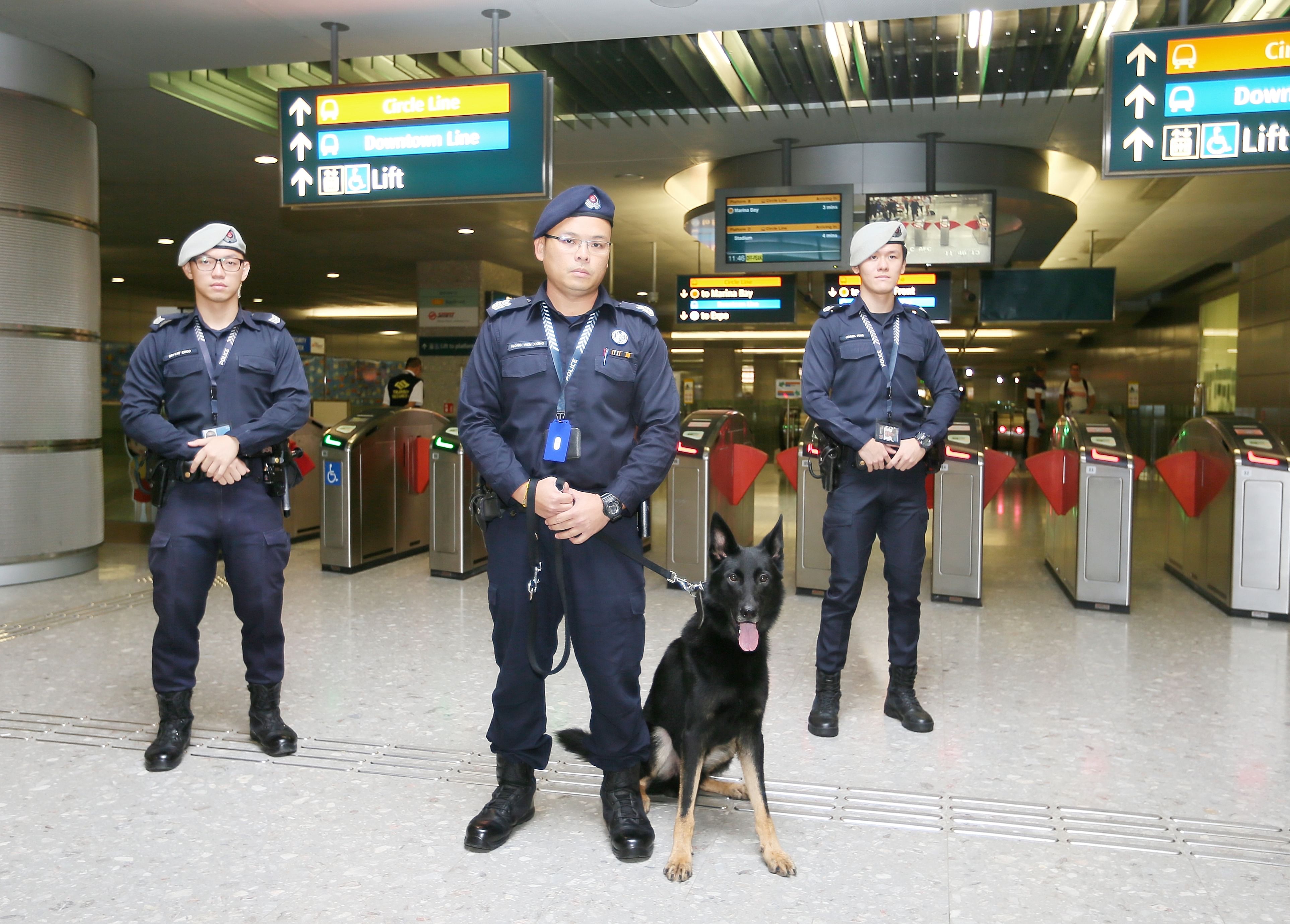SINGAPORE - Security on the public transport network will be stepped up this holiday season, as the number of arrests made at public transport stations hits a three-year high.
On Wednesday (Dec 6), a police spokesman said there will be patrols at more MRT stations and bus interchanges as the festive season approaches.
She was speaking to reporters on the sidelines of a media tour of Mowbray Camp in Choa Chu Kang to observe how police dogs sniff out explosives.
A total of 688 arrests were made between January and October this year, according to new figures from the Public Transport Security Command (Transcom). This is already higher than the full-year figure of 676 arrests for 2016 and 545 in 2015.
Common causes for arrests include being wanted for existing offences, carrying offensive weapons such as knuckle-dusters or possessing stolen items. Each year, more than 50,000 commuters are checked by officers who don the light grey berets.
Sergeant (NS) Bryant Choo, who has been with Transcom since December last year, said that each security check lasts no more than two minutes if commuters cooperated fully.
He said: "We get people who ask us, 'Why me? Why are you conducting a check on me?' Some of them can be very agitated."
But people do largely cooperate when officers explained that the checks are for security, he added.
During the checks, officers will ask simple questions. They may also search pockets and bags and ask for the commuter's particulars to see if they are wanted.
At MRT stations and bus interchanges, officers conduct daily patrols in teams of three or four. A team may consist of two Transcom officers accompanied by one or two officers from the K-9 unit under the Special Operations Command, who bring along their dogs to sniff out explosives, as part of the police's counter-terrorism drive.

Transcom officers follow alongside or behind the dogs, which are leashed, for about 30 minutes at each MRT station. They look out for suspicious behaviour from avoiding eye contact to running away from officers, Sgt (NS) Choo said.
-
More paws on patrol
-
SINGAPORE - The lights and the trees are up, and it's less than three weeks before Christmas.
Besides these merry decorations, the public may see more police dogs too at MRT stations and bus interchanges as the police step up patrols in the run-up to the festive season.
One such dog is Esso, a two-year-old German shepherd whose duty is to keep Singapore's public transport network safe from explosives.
Officers from the K-9 unit - which Esso belongs to - and the Public Transport Security Command pair up when they patrol high-traffic places such as Raffles Place, Bayfront and Bugis MRT stations.
During a press tour at Mowbray Camp near Chua Chu Kang on Wednesday (Dec 6), the police demonstrated how Esso can sniff out explosives.
Guided by Senior Staff Sergeant Wong Wenxiong, Esso went sniffing around some cars parked in the camp, going near their tyres, boots and cars.
When it came to a red car, Esso sniffed around and then sat down on its hind legs - a sign that something was not quite right. In this case, a dummy explosive was hidden near the car's front bumper.
According to the K-9 unit, police dogs start their compulsory 12-week training when they are 18 months old. They are trained to sniff out drugs or explosives in various scenarios.
Their handlers undergo the training with them to build a bond with them.
The dogs have to pass an annual test and go for training modelled after major terror incidents involving explosives in other countries, which are repurposed to fit Singapore's context.SS Sgt Wong, 34, who has had six dogs before Esso in his 12 years in the force, said Esso is still a rookie, having just finished his training a couple of weeks ago.
He said he gives lots of praises and pats to Esso to lift its spirits so that it will look confident when they are on patrol together.
He added: "We also play balls at the MRT stations when nobody is around."
Sgt Choo noted that some members of the public may be sensitive to the presence of a dog.
He said: "We tell commuters not to be alarmed (if they are) and that this is part of our routine. Sometimes, we use ourselves as a barrier between commuters and the dog."
The Straits Times understands that the police have had no complaints from commuters about canines on patrol. The dogs have been trained to respond to their handlers' command and will not approach commuters unless they smell something amiss. Even so, they will "signal" to their handlers and wait for a command before making any move.
Sgt Choo has gone on about five patrols with officers and dogs from the K-9 unit in the past year. They typically patrol high-traffic areas such as Raffles Place, Bayfront and Bugis.
With the approaching festive season, more boots and paws will be on the ground, a police spokesman said on Wednesday.
Ms Jessie Yit, 27, a tourist from Malaysia who was at Bayfront MRT station on Monday, said she feels safer with the police dogs on patrol.
It was her first time seeing a dog on police patrol.
She said in Mandarin: "I'm not afraid of the dogs if they are on leash. It feels safer with them around."
She added: "But I also wonder whether if there's something I should be worried about when I see them on patrol because they do stand out."

